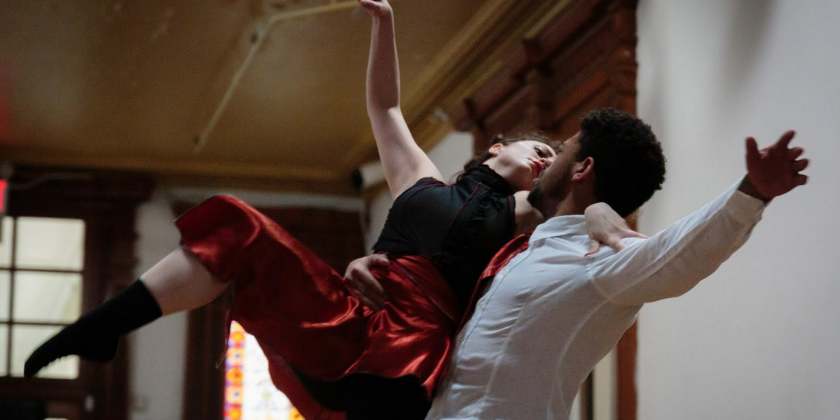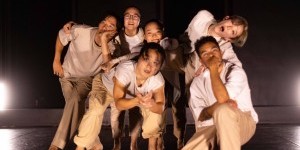AUDIENCE REVIEW: nathan trice / RITUALS Dance. Theater. Music.

Company:
nathan trice / RITUALS
Performance Date:
March 25, 2023
Freeform Review:
Artistic Director/Choreographer Nathan Trice and Snug Harbor Cultural Center & Botanical Gardens’ PASS residency presented nathan trice / RITUALS Dance. Theater. Music., company March 25th, 2023. The afternoon consisted of three works-in-progress; each piece was thought-provoking and raw in both material and messages.
Performed in the center’s Newhouse Center for Contemporary Art building, the artists and audience were treated to an intimate, historic space with beautiful natural lighting. It was a space that invited engagement, conversation and reflection - which was Nathan’s exact intention for the afternoon.
An Inquiry Dynamic (AID): The Future opened the program. AID: The Future is a mentorship program where Millennials and Gen Z participants share contemplative inquiries on the relationship between Humanity & Spirituality, Race & Ecology, and Technology and Morality.
Incorporating movement and monologues, the piece was performed by Jelani Taylor, Mohammed York, Paul Gamble, Arianna Stendardo, Layla Michel, and Annalise McGlashan. AID: (The Future) is a prime example of Nathan’s creative mission, as the work explored questions on the topics of spirituality, humanity, environmentalism, racism, technology, and morality – topics extremely important to Nathan and his collaborators. I can still remember the dancers’ voices reverberating through the space, asking, “What is the missing link between spirituality and humanity?” as they danced with sharp, demanding qualities.
Mohammed York stepped to the center of the stage in the beginning of AID: (The Future), setting the tone with a confident, booming voice that carried throughout the space: “Tell me something…when you look in the mirror, do you know who you are?” Mohammed began dancing a phrase, inviting the other performers to enter the middle. The dancers stepped beyond themselves expansively, their bodies matching the importance of each topic.
Annalise beautifully stated that, “Everyone has their own definition of good…and their own definition of bad…somehow we have decided that these terms have set definitions.” I loved how she looked out at the audience as she spoke her monologue, with a slight smile.
Jelani Taylor in particular moved through the space with precision, speaking as if through a stream of consciousness. Repeatedly, he asked “What does it mean to be human?” while overlapping on stage with Annalise McGlashan.
Layla Michel challenged the audience to think about, “What does it mean to be humane? Is my only job in this world to prolong the human race?” Together, Annalise and Jelani swirled around the space, circling each other. They acted as an element of chaos that brought such power to the work. Jelani echoed Layla while he danced in the background, stating, “Everything is so predictable.” Together, Jelani and Layla put out a yearning for breaking expectations of life.
Another standout solo in AID: (The Future) was by Arianna Stendardo, whose monologue was about spirituality. Her strong voice carried through the back of the house, as she offered, “I believe in fearless people. Not people without fear…I’m talking about someone able to fight that social anxiety, to transform a bad thought, a bad day, into something good for them and for others.” When she danced, her movement quality was open and supple.
Paul Gamble ended the piece on a compassionate note: he asked the audience again, “What is the missing link between spirituality and humanity? What brings you joy and ease are not simple questions, but they do have simple answers.” The dancers lined up behind Paul and came together as a unit, everyone offering a different question as they trickled out of the space, walking to the walls on the side.
Alchemist In The Garden, presented second on the program, was a serene trio. Alchemist In The Garden is a work in progress from Trice’s Recognizing Women Project. It is inspired and will be narrated by prerecorded discussions with groups of fathers on raising their daughters.
Although the dance was inspired by fathers that Nathan interviewed before creating the work, the trio was extremely feminine in nature. Danced by Roxanne Young, Elisabetta Minutoli, and Manatsu Aminaga, these women offered a sensitivity in the way they related to each other and the space around them.
I can still remember the opening moment when the three dancers entered the space, holding two potted plants. They walked around the space slowly, in a way that one is entering a sacred space. They were respectful of the earth they stood on. With precision and care, the dancers placed their plants on the earth, leaving a wide diagonal for them to dance inside.
In this trio, each of the dancers gave space to repeat a similar pattern: one dancer would dance alone in the middle of the plants, followed by the second, and the third. The dancers who were not moving were clearly listening and observing the mover. The three eventually rejoined as a unit and danced together. The dance felt abstract, without characters or spoken word – it was the serene energy that stood out. It was fascinating that interviews with fathers inspired this work, while I felt like I was witnessing three daughters in this work.
Strange Love: EPISODES / Whimsical Interactions & Conversations closed the afternoon. Strange Love is an illustration of ongoing community discussions that seek to identify the internal impulses and external looks of Courtship, Intimacy, and Love. It is a dance for three couples, and is a piece Nathan has revisited several times over the years. This work featured Roxanne Young, William Roberson, Paul Gamble, Arianna Stendardo, Mohammed York, and Elisabetta Minutoli.
In the couples, there was a juxtaposition of calmness and fire in the way they moved together. Each couple shared their own unique story of passion, love, intimacy, trust – all of the things that couples go through together.
This piece tied together an excerpt of audience participation from before the beginning of the program. Before the performance, volunteers from the audience were prompted to write responses to the following questions:
What is [your] favorite part about courtship?
In 2-3 words, what is the most memorable dynamic about intimacy [to you]?”
These responses were condensed to about two to three words, and were displayed in large print, written by the dancers on posted-sized sheets of paper in the upstage space. The audience was able to see the dancers dancing about relationships, and also read the audience’s thoughts about relationships. It felt like a real-time investigation about passion and what it means to be in a partnership and conversation.
The audience saw various sides of a couple’s relationship. Snapshots and vignettes presented an abstract approach of what it is like to partner someone in life. Passion, trust, honesty, disagreements, conversation, and love were portrayed by each couple.
Each work on the program has been developed through community discussions as a way to foster exposure, access and inclusion to art making, as a way to illustrate what is most commonly understood and valued.
As I left the performance, I was compelled to contemplate the important ideas that Nathan Trice’s work explores. It was refreshing to see a performance that offered both beautiful movement and important questions. Congratulations to all artists involved with nathan trice/RITUALS Dance. Theater. Music.!
Author:
Kristen Hedberg
Website:
kristenhedberg.org
Photo Credit:
Tony Turner





